In today’s fast-paced and ever-changing tech industry, leaders face a multitude of challenges. From balancing cost efficiency with innovation to navigating the uncertain economic landscape. Management and leaders must be equipped with the essential skills and strategies to succeed.
At a recent leadership meet-up, some of the most forward-thinking minds in the tech industry came together to discuss the challenges and solutions that leaders in this space are facing today. They offered valuable insights and practical strategies for anyone looking to stay ahead of the curve in this rapidly changing field. In this article, we’ll take a closer look at some of the key takeaways and highlights from the summit.
Diversity and Team Engagement
As the tech industry continues to evolve, leaders must be able to adapt and thrive in an environment of uncertainty and change. As companies expand their reach and include a more diverse global team, this also comes with new and unexpected challenges.
Sylwia Chada shared a powerful story from her experience as ex-General Manager of TikTok Poland. When, to her surprise, she received a low score on her managing skills at her first performance review, Sylwia decided to step out of her comfort zone and engage with her team. “I listened to their needs, admitted my mistakes, and built a team based on common values and vision,” she says.
It’s important for leaders to be actively involved and approachable, to build a team that feels safe, and to be willing to take advice and make changes based on feedback. “As leaders, we must be like rowers in a boat, paddling alongside our team instead of just watching from the sidelines,” adds Chada.
Cultural differences, language barriers, and varying work styles can all impact team dynamics and overall productivity. Therefore, it is crucial for leaders to not only understand the technical aspects of their business but also the human aspects of managing a diverse team.
Growing Pains
As a company grows and scales, their philosophy must evolve and adapt to new developments and cultural differences in different geographies. When companies go through mergers and acquisitions, it is crucial to integrate the new management team and ensure they understand the decision-making process and execution of actions.
Innovecs’ COO Dmitry Kushnir spoke of the importance of a tangible management philosophy as a driving force for company leadership culture. A well-defined philosophy can bring focus on achieving results and lead to job satisfaction for employees.
Kushnir suggests five pillars for an effective management philosophy:
- Make it a strategic focus: Philosophy should be aligned with the company’s overall mission, vision, and goals. When management philosophy is integrated into the strategic planning process, it becomes easier to communicate and execute throughout the organization.
- Invest in training and mentoring for the management team: Provide managers with the right tools, resources, and guidance that can help them develop the skills they need to lead effectively. This includes training on topics such as communication, conflict resolution, team building, and performance management.
- Promote diversity: Create a workplace culture that values and respects differences. This will help create a more inclusive environment, which can lead to improved creativity, innovation, and problem-solving.
- Value execution: Create a culture that prioritizes action and results. Managers and team members should be empowered to take ownership of their projects and be held accountable for delivering results.
- CEO and C-level execs lead the way: An effective management philosophy should be led from the top down. When the leadership team models the behavior they want to see in their managers and employees, it can help create a culture of accountability and continuous improvement.

When a company expands globally, it’s essential to adjust and introduce best practices learned while remaining open to diversity. For instance, when working with a Vietnamese team, Dmitry recognized that management decisions prioritize the well-being of their team. This included allowing employees to take a nap at their workplace after lunch, resulting in better engagement and increased productivity.
Leadership Essentials in Distributed Teams
Asynchronous work is a reality in globally distributed teams and transparency is a crucial aspect for strong leadership. Clear communication and creating a sense of purpose and belonging for team members is essential. CEE Customer Program Manager at Microsoft, Izabela Duiwe, shared some examples for promoting transparency:
- Share the company’s mission: translate it into team goals to help everyone understand how their work contributes to the broader picture.
- Record top leadership meetings: share them with the entire team and allow them to see the process and thinking behind decision-making.
- Connect with your team: record a casual 5-minute video about your work or have weekly check-ins.
- Empower people during reviews and encourage them to prepare and present their initiatives to top management to promote a sense of belonging.
- Transparent promotion and recognition can also be motivating. Making promotions visible and discussing the reasons behind them can help everyone understand what it takes to advance in the organization.
To thrive, distributed teams need an inclusive environment where everyone feels valued and heard. This requires virtual and physical catch-ups, education, mentoring, and respect for work hours. Leaders must differentiate between important and urgent matters and filter and direct them accordingly. Creating a culture of openness and collaboration builds a strong and resilient team that can succeed in any environment.

Navigating Challenges in Tech Leadership
During a panel discussion, four tech experts discussed the challenges that the industry is currently facing, including mass layoffs, cost cutting, and decreased investments. Continued growth and innovation are expected from tech companies, even in the face of uncertainty – how are these leaders changing their goals to adapt and find balance?
Innovation requires leaders to be open-minded about changing the way things have been done in the past. Narrowing focus to what can be done efficiently while still growing has been pivotal this year for Alex Lutskiy, the Founder and CEO of Innovecs. He emphasized the importance of encouraging upskilling and giving individuals more ownership to create more effective teams. Magdelena Adach, a Consulting Account Executive at Microsoft, added that keeping your team motivated and engaged will encourage innovation. She also suggested that a curious mindset and openness to changes are key to self-development, and that working as a team can achieve more than working alone.
“We are fueled by innovation,” says Alliance Partner Marketing Lead EMEA at Hewlett Packard, Aik Arutunian, “Do we really have a choice?”. Echoing the sentiments of his panelist counterparts, he points out that innovation is the goal and that old habits can stunt growth, adding that intentional personal growth is just as important in the quest for staying competitive, effective, and relevant.
When it comes to continued innovation in the face of an economic downturn, Kateryna Nakonechna, the Senior Regional Director at GMS, suggested that companies can cut costs without layoffs by outsourcing, leaner processes, hiring internally, and automation.

A Culture of Collaboration
The rapidly changing tech industry poses several challenges to leaders in the field. However, this leadership summit provided valuable insights and practical strategies for anyone looking to succeed. From building diverse teams to managing growing pains, and leading distributed teams, the summit covered it all.
Leaders in the tech industry must be equipped with essential skills and strategies to adapt and thrive in an environment of uncertainty and change. By creating a culture of openness, collaboration, and inclusivity, leaders can build strong and resilient teams that can succeed in any environment.
